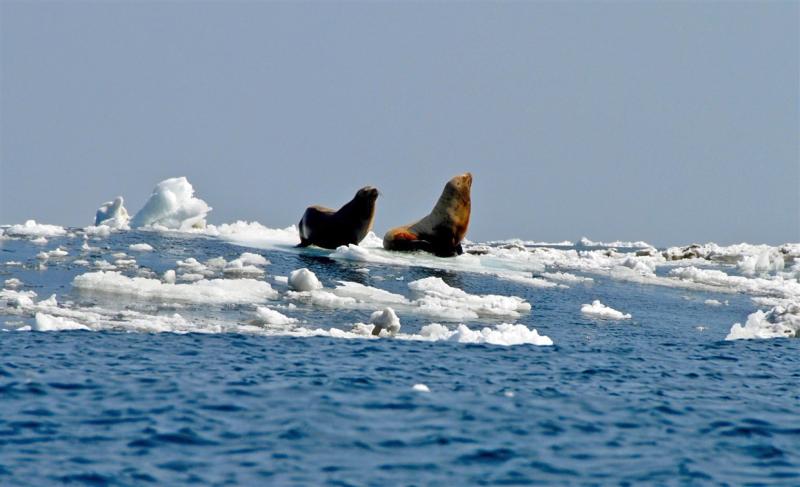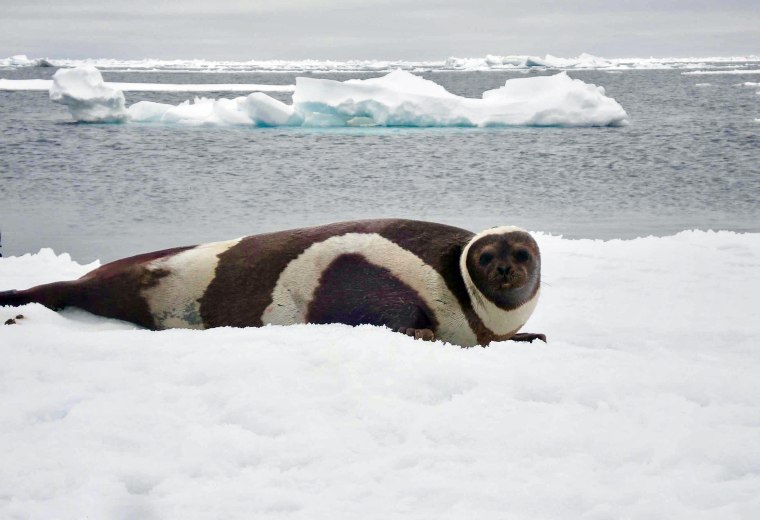A deadly virus is spreading in marine mammals. Scientists say climate change is to blame.



When a deadly virus that killed tens of thousands of European harbor seals in the northern Atlantic Ocean in 2002 began threatening sea lions, seals and otters in the northern Pacific Ocean, scientists were initially puzzled.
The highly contagious phocine distemper virus — which is not believed to affect humans — attacks the respiratory and nervous systems of some marine mammals. But there was no indication it had infected animals that could have taken it to different parts of the world.
“How did a virus that had previously been seen in the Atlantic Ocean end up in the Pacific Ocean?” said Tracey Goldstein, associate director of the One Health Institute at the University of California, Davis, School of Veterinary Medicine.
Goldstein and some of her colleagues examined 15 years of data that included measurements of Arctic sea ice and data from animals that had been tagged by the National Oceanic and Atmospheric Administration and other institutions to study their migration patterns.
Their conclusion: Melting Arctic sea ice brought on by the Earth’s warming climate created a way for the virus to move into a new region and infect a new population of sea life.
 Ribbon seal. NOAA Fisheries, Polar Ecosystems Program
Ribbon seal. NOAA Fisheries, Polar Ecosystems Program “It was a perfect storm in 2002,” she said. “It was the lowest ice year on record at the time, and at the same time, in August and September, there was a really large outbreak.”
The work of Goldstein and her colleagues, published Wednesday in the journal Scientific Reports, also used blood and nasal swab samples from seals, sea lions and otters from southeast Alaska to Russia to assess which populations had been infected with the virus, and which specific strain they had been exposed to.
The researchers noticed a link between sea ice losses in the Arctic and spikes in outbreaks of the disease. In particular, the scientists found that drastic reductions in sea ice on the Russian side of the North Atlantic coincided with increases in exposure rates in both ocean basins. The melted ice, Goldstein said, was likely opening up new waterways for infected animals to come into contact with other species.
The study adds to growing research that global warming is having some unexpected impacts on animal and human health, such as increasing outbreaks of toxic algal blooms that can sicken marine animals and widening the range of ticks that carry potentially devastating diseases.
There’s no evidence to suggest that phocine distemper virus can be transmitted to humans, but the virus belongs to the same family as the measles. And like the measles, it’s highly virulent.
The virus is likely being spread among the animals when they gather to nest and breed, or when they feed in close proximity, according to the study’s lead author Elizabeth VanWormer, who conducted the research as a postdoctoral researcher at UC Davis but is now an assistant professor at the University of Nebraska, Lincoln.
Enabling transmission of the distemper virus is not the only way that climate change is impacting animal health. Along the west coast of the United States, warming ocean temperatures have intensified outbreaks of harmful algal blooms that can sicken marine mammals, said Shawn Johnson, the director of veterinary science at The Marine Mammal Center in Sausalito, California, who was not involved with the new research.
“We’re seeing more and more of these toxic blooms affecting our animals,” Johnson said. “This is not unique. It’s just another important piece of evidence showing that climate change is impacting the marine mammals all up and down the West Coast.”
The study’s findings have implications not only for marine mammal populations but also the delicate balances that exist within ecosystems.
“When we see these changes happening in animals, we can’t ignore them, because the impacts on people and the planet are not far behind,” VanWormer said. ”This shows how interconnected these things are — the health of people, animals and the planet.”
The research should also act as a warning sign for the potential impacts that climate change can have on the ability to fight diseases and prevent their spread, according to Johnson.
“The climate is changing so rapidly,” he said. “Understanding how diseases and the ecology of diseases are changing in wildlife and marine mammals will give us insight into the future, and how we need to be prepared for a new paradigm of disease transmissions in animals and in humans.”


If the sea dies.... we die.
Science better:
I guess it's a race to see who/what can wipe out the whales first, the virus or the Japanese.
"A deadly virus is spreading in marine mammals. Scientists say climate change is to blame."
I like putting the "blame", where "blame" is REALLY due.
I BLAME THE VIRUS !
Spent a fortune earning a few degrees in environmental and medical science. Sad that so many know so little about how our planet works and care so little about protecting it from ourselves.
Then you should understand that anthropogenic climate change is a self-correcting problem. Unfortunately scientists keep interfering with the natural processes that will allow the problem to resolve itself. Nature will reduce the size of the human population (and reduce anthropogenic impacts on nature). The natural processes will eventually overwhelm the ability of science to interfere.
Look, fossil fuel companies aren't just burning coal, oil, and gas to pollute the atmosphere. Science created a technological future that promised the human population a lifestyle of convenience, comfort, and leisure requiring less effort. Technology is the root cause of anthropogenic climate change. The real history of technology suggests more technology is not a viable solution.
Scientists claim that eliminating technology will force humans to live like cavemen. But cavemen did not cause climate change; climate change has been caused by the creation of a technological society. And cavemen apparently survived and thrived without technology; otherwise we wouldn't be here.
The climate change cultists are worse than the creationists, and have become very dangerous to our democracy and freedoms.
Wow. The complete lack of caring is on display.
Just read an article that now there is a transmittable cancer passing among sea life.
Thinking that people have no impact on the planet is just burying ones head in the sand.
In this particular case there is no evidence that a bit of alleged climate change is causing this virus to disperse.
It is foolish claims like this that keep shooting down the ongoing propaganda balloon sent up by climate change cultists.